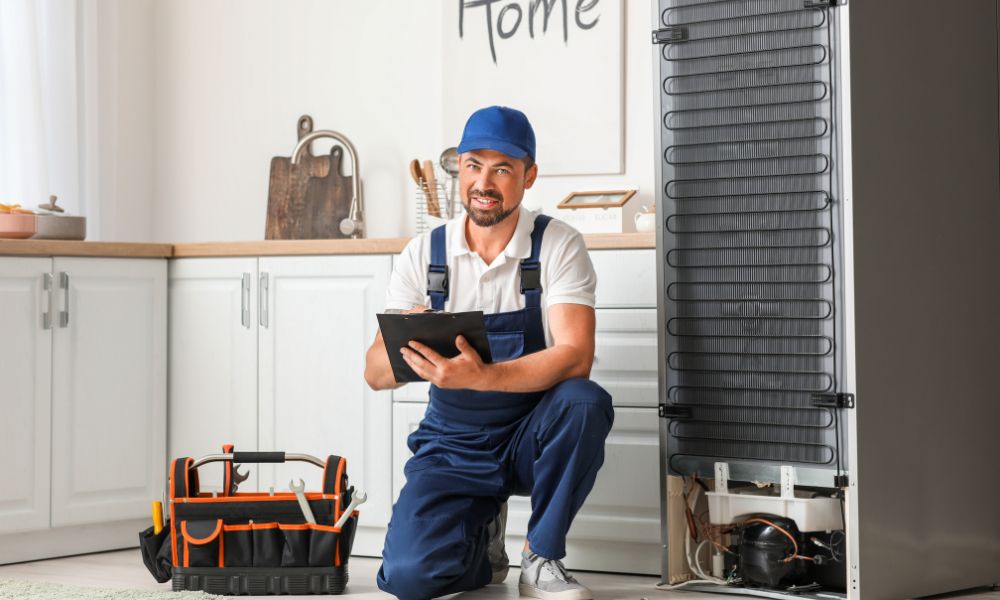Have you ever found yourself in a state of panic when your beloved appliance suddenly stops working? The fridge that keeps your food fresh, the washing machine that ensures clean clothes, or the stove that prepares delicious meals – we rely heavily on these appliances for our everyday needs. But fear not! In this article, we will take you through a step-by-step guide on how to repair appliances and save yourself from unnecessary stress and expenses. Whether you’re a DIY enthusiast or just looking to troubleshoot minor issues, this comprehensive guide will equip you with the knowledge and skills needed to get your appliances back up and running in no time. So grab your tools and let’s dive into the world of appliance repair!
Why repairing appliances is cost-effective.
Repairing appliances can be a cost-effective solution compared to instantly replacing them. Not only will it save you money, but also minimize waste in our environment. Often, the issues with an appliance are minor and can be easily fixed without spending a fortune. By opting for repair instead of replacement, you are not only extending the lifespan of your appliance but also reducing the demand for new ones, which ultimately reduces the strain on our planet’s resources.
Repairing appliances allows you to have more control over your budget and avoid unnecessary expenses. Buying a brand-new appliance can be a substantial investment that may not always align with your financial capabilities or priorities. However, by repairing what you already have, you can allocate your resources more effectively and potentially save thousands of dollars in the long run.
Furthermore, repairing appliances showcases resourcefulness and an appreciation for craftsmanship that has become increasingly rare in today’s throwaway culture. Rather than giving up on a malfunctioning item at the first sign of trouble, choosing to repair it demonstrates patience and problem-solving skills. It allows us to develop new insights into how things work and gain valuable knowledge about fixing everyday household items ourselves or by seeking professional help when needed.
Assess the problem:
Assess the problem: One of the most important steps before attempting to repair an appliance is to assess the problem accurately. While some issues may be straightforward, others may require a closer inspection and diagnostic approach. It’s important not to jump to conclusions or assume a quick fix without understanding the root cause of the problem. Taking the time to thoroughly assess the appliance will not only save you time in the long run but also prevent any unnecessary damage during repair.
Identify common culprits: When faced with a malfunctioning appliance, it can be helpful to familiarize yourself with common issues that often plague certain appliances. For example, refrigerators might frequently encounter cooling problems due to clogged air filters or malfunctioning compressors. By being aware of these common culprits, you can narrow down your diagnosis and potentially address the problem more efficiently.
List of essential items for repair.
When it comes to repairing appliances, having the right tools and equipment can make all the difference. Here’s a list of essential items that every DIY repair enthusiast should have in their arsenal.
1. Multimeter: A multimeter is an indispensable tool for diagnosing electrical problems in appliances. It can measure voltage, current, and resistance, helping you pinpoint faults accurately.
2. Screwdriver Set: Different appliances may require different types of screwdrivers for disassembly and reassembly. Investing in a comprehensive screwdriver set with various sizes and types will ensure you have the right one for any appliance repair job.
3. Needle-Nose Pliers: These long, thin pliers with pointed ends are perfect for gripping small wires or reaching into tight spaces during repairs.
4. Wire Strippers: When dealing with electrical connections, wire strippers are necessary to remove insulation from wires without damaging them.
5. Adjustable Wrench: An adjustable wrench enables you to tighten or loosen nuts and bolts of different sizes when working on appliances containing plumbing connections.
6. Thermal Paste: This heat-conductive compound is used to ensure optimal thermal transfer between electronic components and heat sinks, preventing overheating issues in devices like laptops or gaming consoles.
7. Zip Ties: Keeping cables organized inside appliances not only improves efficiency but also reduces the risk of accidental damage caused by tangled wires. Zip ties come in handy while securing cables neatly during repairs.
With these essential items at your disposal, you’ll be well-equipped to tackle common appliance repairs like a pro!
Provide detailed instructions for fixing the appliance.

When it comes to fixing appliances, attention to detail is key. While it may be tempting to dive right into the repair process, taking a step back and thoroughly examining the issue can make all the difference. Before grabbing your tools, take a moment to assess what could potentially be causing the problem. Is there a loose wire or a faulty component that needs replacing? By pinpointing the exact issue, you’ll have a clearer idea of what steps need to be taken for an effective repair.
Once you’ve identified the problem with your appliance, don’t shy away from seeking out detailed instructions online or in appliance repair manuals. These resources often provide step-by-step guides tailored specifically to your model of appliance, allowing you to confidently tackle even complex repairs. Avoid rushing through these instructions and take note of any potential pitfalls or safety precautions along the way. Remember, being patient throughout the repair process can prevent further damage and ensure optimal functionality in the long run.
However, it’s important to keep in mind that not all appliance repairs should be attempted on your own. Certain issues may require professional help or specialized tools that are beyond your expertise and resources. When dealing with gas-powered appliances or complex electrical systems, it’s always best to consult with trained professionals who can guarantee both safety and reliable repairs.
Ensure that the repair was successful.
Ensuring that a repair was successful is not just about fixing the immediate issue at hand; it also involves taking steps to prevent future problems. Once your appliance has been repaired, it’s important to closely monitor its performance and functionality in order to validate the success of the repair. One way to do this is by paying attention to any unusual sounds or vibrations that may occur during its operation, as these could indicate underlying issues that were not addressed during the repair process.
Additionally, it is crucial to follow the recommended maintenance procedures for your appliance after it has been repaired. Regular cleaning and servicing, such as removing built-up dust and debris or lubricating moving parts, can help prolong the lifespan of your appliance and prevent further breakdowns. By taking proper care of your newly repaired appliance, you are actively contributing to its long-term health and reducing the likelihood of costly repairs down the road.
Important tips to stay safe during repairs.
When it comes to repairing appliances, safety should always be the top priority. Before you even begin any repair work, make sure to disconnect the appliance from its power source. This may seem like common sense, but many accidents occur due to people forgetting this crucial step. Additionally, wearing protective gear such as gloves and goggles can prevent injuries and ensure your wellbeing while handling tools or potential hazardous materials.
Another important tip is to take your time and read through the manufacturer’s instructions or consult a repair manual before starting any repairs. Trying to rush through the process without proper knowledge can lead to costly mistakes or even further damage the appliance. Remember that each appliance has its own set of specifications and procedures for repairs, so taking a moment to educate yourself will go a long way in ensuring success.
Lastly, if you’re unsure about tackling a complex repair job on your own, don’t hesitate to call in professional assistance. While it’s rewarding to fix something yourself, some repairs require specialized skills and expertise that only trained technicians possess. It’s better to be safe than sorry when it comes to complex appliances that could potentially harm you or cause significant damage if not treated correctly.
Conclusion:
Repairing a broken appliance can save you time, money, and frustration. By troubleshooting the issue and attempting to fix it yourself, you may be able to avoid the cost of hiring a repair technician or purchasing a new appliance altogether. Additionally, repairing appliances can be a rewarding DIY project that allows you to learn new skills and gain a sense of accomplishment. However, it is important to know your limitations and seek professional help if needed. So next time an appliance breaks down, don’t immediately rush to replace it – consider repairing it instead and reap the benefits. Take charge of your appliances and become a confident DIY repairer today!


2 thoughts on “How to Repair Appliance ”
Thank you for sharing this blog.
This comprehensive guide is a lifesaver! I’ve often felt helpless when my appliances break down, but now I feel empowered to tackle repairs myself. The tips on assessing problems and the essential tools list are invaluable. Plus, repairing instead of replacing is not only cost-effective but also eco-friendly. Thank you for this insightful article!